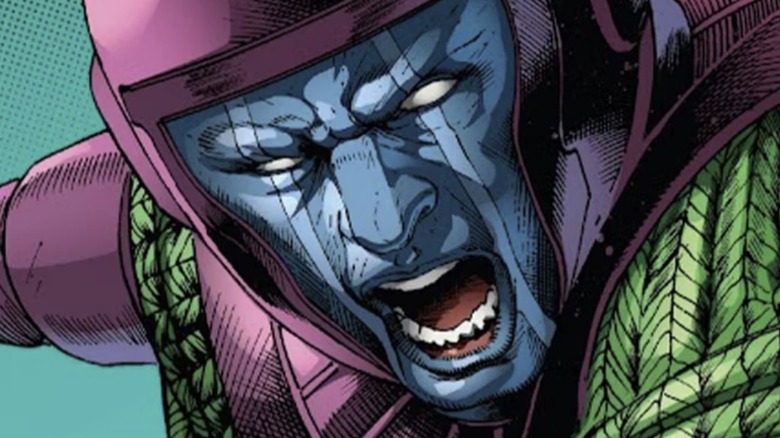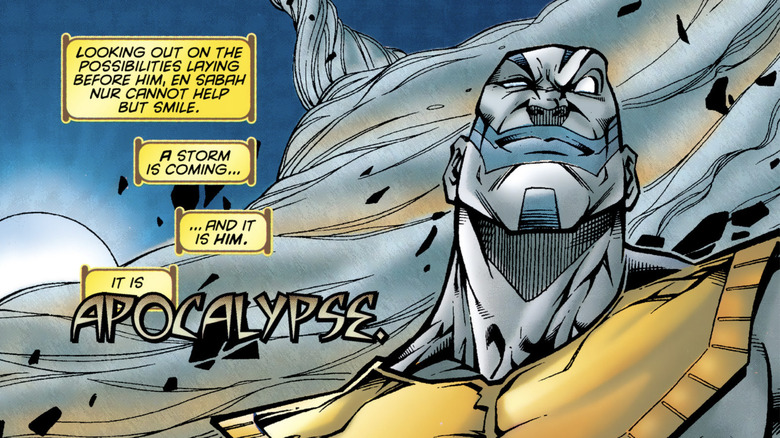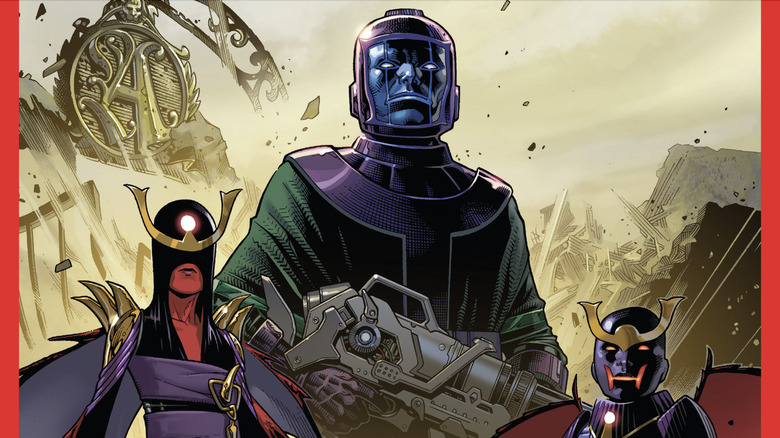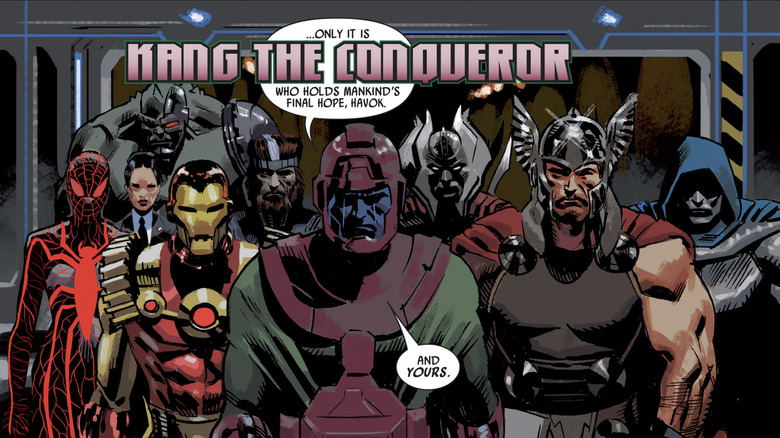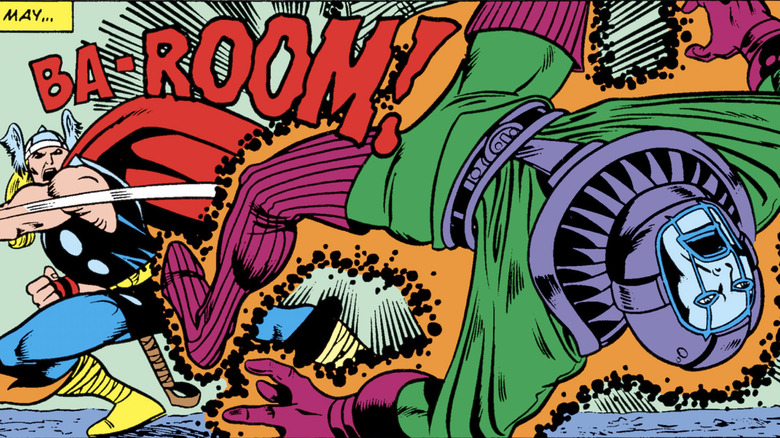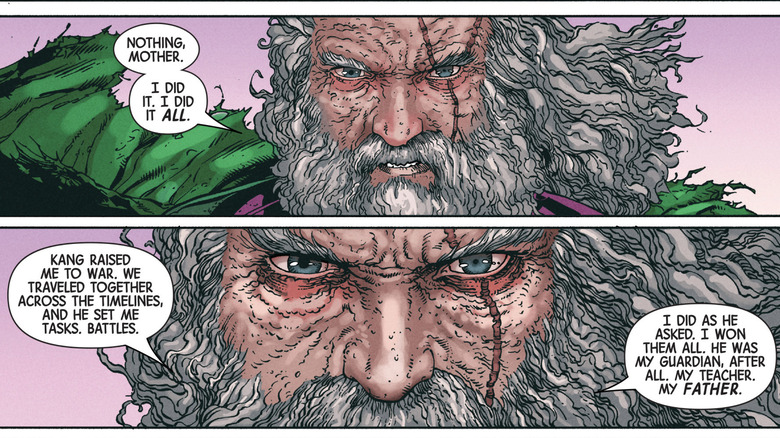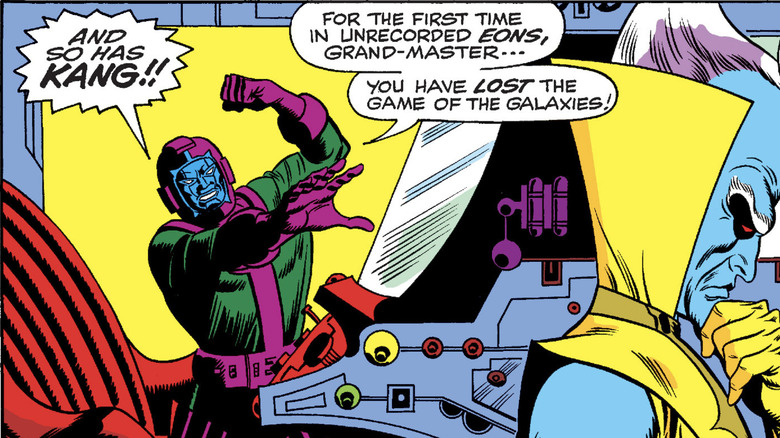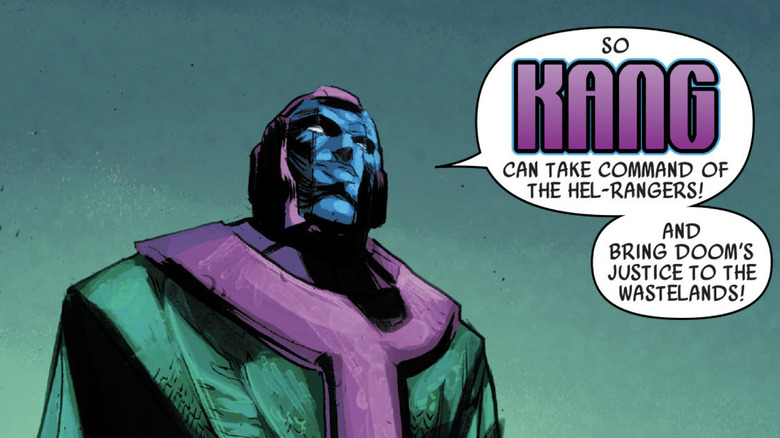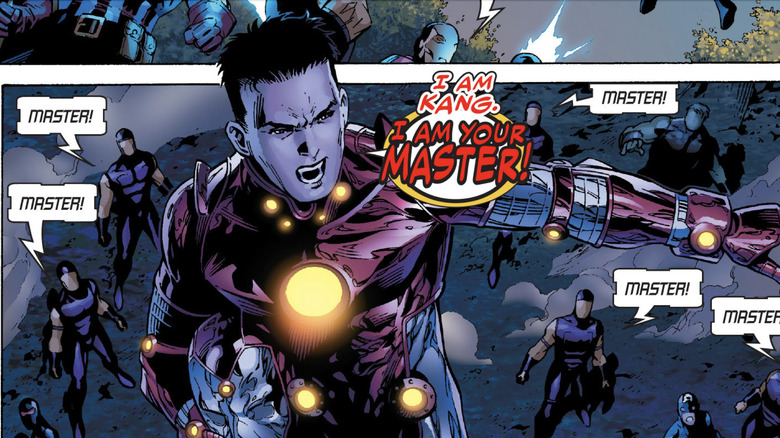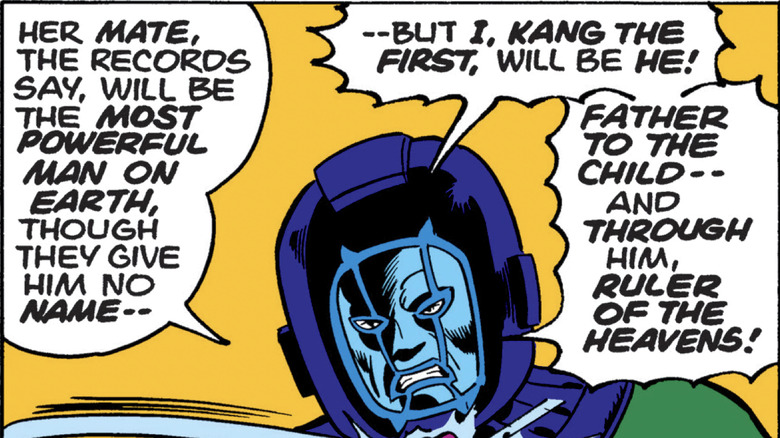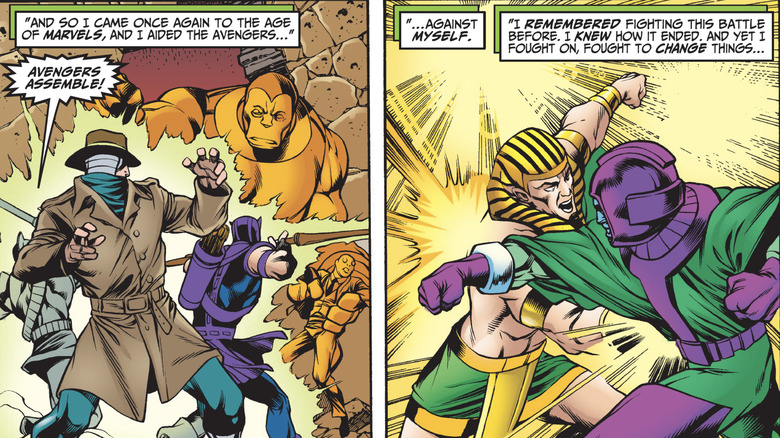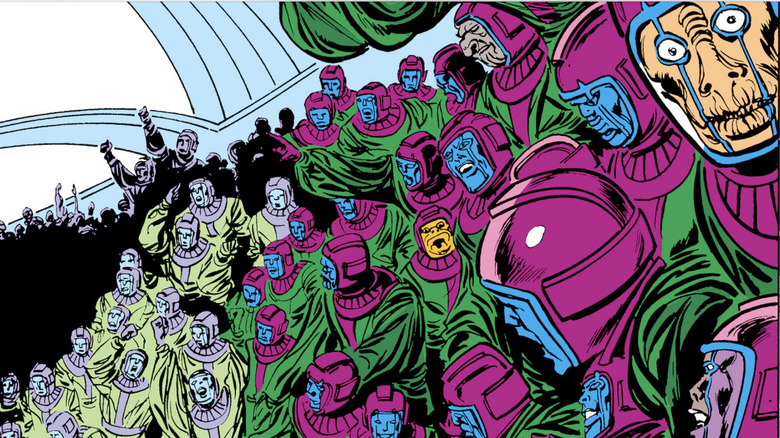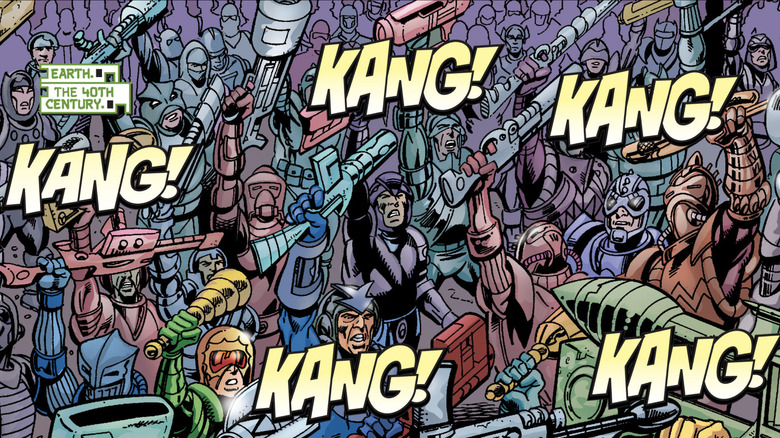12 Best Kang The Conqueror Moments From The Comics Ranked
Move over Thanos, the new big bad in the Marvel Cinematic Universe is Kang the Conqueror, the time-traveling, reality-shaping, world-destroying despot with an insatiable need to dominate the universe (and an equally powerful need for a costume makeover). First appearing at the end of the Disney+ series "Loki," Kang immediately upped the ante and the stakes for the MCU, establishing an entire multiverse, complete with infinite realities, infinite heroes — and a potentially infinite amount of alternate Kangs.
As you'd expect from such an omnipresent threat, Loki is not the only MCU fave to run afoul of the tyrannical time-lord, as Kang undoubtedly features heavily in "Ant-Man and The Wasp: Quantumania" and "Avengers: The Kang Dynasty." However, the MCU is not alone in facing the wrath of Kang, as the character has appeared time and time again in Marvel Comics to vex virtually all of its major heroes.
Since the early issues of "Fantastic Four" and "Avengers," Kang has proven himself to be one of the greatest Marvel villains, playing a major role in some of Marvel's biggest events and delivering scores of memorable moments. For anyone looking for the inside scoop on the MCU's new Avengers-level threat, here we've gathered and ranked the 12 best Kang the Conqueror moments from the comics.
12. The father of good and evil
It won't come as a surprise to any connoisseur of time travel stories, but the time-skipping, multiverse-hopping Kang has a twisting, turning labyrinth of a backstory. It involves multiple realities' versions of Kang and numerous alternate histories and futures. Likewise, the myriad results of his repeated meddling with the timestream have established backstories for a few major Marvel characters.
One of Kang's inadvertently positive creations is obvious upon learning his birth name: Nathaniel Richards. That's right, Kang — an alternate reality version of him — is the father of Reed Richards, aka Mr. Fantastic of the Fantastic Four. The version of Kang that produces Reed is from the primary Earth of Marvel canon, Earth-616, and his relatively charmed life keeps him from becoming a full-on Kang. He grew up on an Earth without cataclysmic war, and so is able to maintain the identity of Nathaniel Richards instead of succumbing to his darker nature.
Another Nathaniel Richards, the version from Earth-6311, lets the darkness take over, and instead of Mr. Fantastic, enables the creation of the mutant dictator Apocalypse. This Nathaniel decides to use his genius to travel back in time to Ancient Egypt, which he conquers, renaming himself Pharaoh Rama-Tut. Knowing that a young local mutant named En Sabah Nur — destined to become Apocalypse — is about to discover his powers, Rama-Tut seeks to make the boy his heir. Though unsuccessful, his violent pursuit of Nur is ironically what causes the mutant to become Apocalypse in the first place.
11. Raising the Apocalypse Twins
Because Kang's schemes are never as simple as they seem, his relationship with the mutant overlord Apocalypse goes much deeper than simply turning him evil. If there is any one word to describe Kang it is tenacious, so when his plan to establish Apocalypse as his heir fails, Kang bides his time until he can enact the next best (and devilishly poetic) plan: stealing Apocalypse's heirs for his own.
The heirs in question are Uriel and Eimin, son and daughter of two of Apocalypse's Four Horsemen, and therefore claimants to his throne. Immediately after their birth, Kang time-travels into their nursery and steals them, transporting them to the distant future where he can safely raise them as his own. When they reemerge in what would have been their present day, the twins have aged into young adults, suggesting that Kang raised them for 20 years or more, and they are — if possible — even more bloodthirsty than Apocalypse. Back in the present day, the twins wreak almost unprecedented havoc on a global scale, killing supposed friend and foe alike — including Apocalypse's genetic son, Genocide — and even defeating and killing a Celestial. Uriel and Eimin are so vicious and power-hungry that they even attempt to erase Kang himself from existence.
10. Founding the Cronos Corps
You'd be hard-pressed to define any of Kang's endeavors as "heroic" — even Marvel.com tried to list Kang's most heroic moments and only managed to generate a handful of occasions when Kang's aims briefly aligned with those of the Avengers. But even if Kang has never been a champion for the common good, he has at least accomplished some good deeds, if accidentally. One of those moments — and one of his coolest contributions to the Marvel multiverse — is when he establishes the Cronos Corps, a motley band of time-displaced heroes and villains from across the multiverse, who gather together with the sole purpose of defeating the Apocalypse Twins.
After a long period of planning, Uriel and Eimin escape Kang's future fortress, steal one of his most powerful weapons, and return to the past against Kang's plan — the combined effect of which is enough to reset the past and erase Kang from ever existing. What the twins fail to realize, however, is that Kang is gonna Kang. More accurately, given his pan-temporal nature, Kang is gonna Kang, Kang is currently Kang-ing, and Kang has always Kang-ed. After he and his uber-powerful Cronos Corps defeat the twins, he asks Eimin, "Did you think that I hadn't foreseen your treachery?... You have served the only purpose you were ever any good for. You have served Kang."
9. Kang vs. Thor in the Wild West
Even the most casual readers of Golden and Silver Age comics are no doubt aware of the eras' inherent silliness. Before the medium was reinvented in the '80s (via Nerdist) with the popularity of indie comics and the move towards more adult themes in the mainstream, comics in general skewed towards whatever simple, splashy stories could get issues in the hands of younger readers. That meant a lot of sci-fi, fantasy, and fan service, one of the prime examples of which is when Kang fought Thor in the Wild West.
Though of course, the setup for such a battle is long and winding, the short version is that previously, Hawkeye had become lost in time, and Avengers Thor and Moondragon go back to the Wild West to look for him. After finding their lost teammate, they unite with heroes from that era like the Two-Gun Kid, the Rawhide Kid, Kid Colt, the Ringo Kid, and other uncreatively named gunslingers to battle the man who led them all back there in the first place: Kang the Conqueror. While the other Avengers and cowboys are busy fighting a scientifically-mutated coyote (we told you this was silly), Thor and Kang duel, seemingly resulting in Kang's complete dissolution. Despite his apparent death, Kang escapes and makes his predictable return in a later Avengers issue entitled "Kang Lives!"
8. Stealing Black Bolt's son
A clear, consistent trend emerges from reading through dozens and dozens of comics featuring Kang: that dude has major daddy issues. As Jennifer Walters pointed out during the "She-Hulk" finale, a lot of Marvel characters seem to suffer in the shadows of their fathers, but even the likes of Tony Stark and Star-Lord can't compete with all the daddy issues that belong to Kang the Conqueror. It's hard to find a major Kang story that doesn't involve him trying to sire sons, train surrogate sons, reveal secret sons, discover his secret father and grandfathers, or — to the tremendous misfortune of Black Bolt, king of the Inhumans — steal another person's son.
To be fair to Kang, Black Bolt willingly places his son Ahura in Kang's care. As a member of the Illuminati, Black Bolt has privileged information, namely that the multiverse is collapsing. In order to save Ahura's life, he asks Kang to take him else-when in time, but as Kang is known to do, he alters the deal. Kang doesn't just raise Ahura — he transforms him into every bit the conqueror that Kang is. By the time Black Bolt and the rest of his Inhuman cadre manage to find Ahura in the timeline, he is too far gone. After an unhinged speech in which Ahura asserts, "I am the conqueror and I have worlds to burn," Black Bolt is forced to kill the monster that used to be his son.
7. A game with the Grandmaster
One of the best surprise supporting roles in the MCU was Jeff Goldblum as the Grandmaster, the hilariously eccentric despot in charge of the planet Sakaar. He appeared in "Thor: Ragnarok" (and, according to Goldblum, also cameoed "only vibrationally" in "Thor: Love and Thunder"), delighting audiences with his trademark Goldblumian playfulness and quirkiness. His comic book counterpart, however, is anything but delightful, instead opting to play games using Marvel's heroes and villains as pawns. During one such game, he chooses Kang the Conqueror as his opponent, and the combination of the two egotistical villains turns as sour as you would expect.
When the Grandmaster hears Kang's desperate pleas to gain enough power over life and death to save his beloved Ravonna Renslayer — the same Renslayer from "Loki" — the Grandmaster arrives and offers him the power he seeks, if only Kang can beat him in a contest. The contest is a battle between chosen champions: Kang's Avengers and the Grandmaster's Squadron Sinister. Kang and the Avengers eventually win, but even with the fate of his true love at stake, Kang can't resist the allure of a good conquest. He reneges on every agreement and attempts to kill the Avengers and the Grandmaster, ultimately defeated by his mortal enemy: his hubris.
6. Kang: Agent of SHIELD
There are a lot of Kangs. Like nearly every Marvel character, there is roughly one alternate Kang per universe, but unlike the other characters, Marvel readers have actually met a metric ton of alternate Kangs. Sure, "Into the Spider-Verse" had its share of Spider-People (and "Across the Spider-Verse" looks to have even more), but no Marvel character, Spider or otherwise, has as many alternates as Kang. Of all those alternates, one of the absolute strangest — and best — is the Kang from "Secret Wars," an agent of one very unusual SHIELD.
On Earth-616, as well as most Earths in the multiverse, SHIELD acts as a global peacekeeping force, but the "Secret Wars" version is entirely its own. On that Earth, which is really just a small pocket universe stitched together by Doctor Doom from the last remnants of the collapsed multiverse, SHIELD's only duty is to defend a massive wall from the rampaging hordes beyond. That's right, this version of Kang is essentially Jon Snow, a watcher on a wall, protecting his lands from the supernatural terrors beyond. Like Snow, this Kang gives his life defending the wall, and again like Snow, the wall is nonetheless thoroughly breached.
5. Founding the Young Avengers
As if Kang the Conqueror's backstory/forward-story/side-story wasn't convoluted enough, he recently (as comic book time goes) acquired yet another alternate — this one a founding member of the Young Avengers.
When the Young Avengers first form, each of the teens choose a specific core Avenger to emulate — Asgardian is a nod to Thor, Patriot pays tribute to Captain America, Hulkling is based on Hulk, and Iron Lad points to Iron Man. It's the latter kid that is ultimately revealed to be another version of Kang, and in a way, his story is even stranger than most others.
Like most Kangs, Iron Lad comes from an Earth separate from the 616 version, in this case Earth-6311. If that Earth sounds familiar to you, it's because that's the same Earth that the "main" Kang — the Kang who traveled back in time to rule as Rama-Tut and later took on the mantle of "Conqueror" — comes from. Iron Lad, however, is fortunate enough to encounter his older self from the same Earth, and upon seeing how evil he will become, vows to escape that time and reality. Attempting to become a hero instead of a conqueror, Iron Lad travels to the modern era of Earth-616 and does his best to alter his grim destiny. Though he ultimately fails and becomes yet another Kang, Iron Lad at least proves that even the worst of Kangs have the potential to do good.
4. Celestial Madonna
If you've kept up with every MCU project thus far, and we're willing to bet you have, then follow this hypothetical situation. If you knew one MCU character was the Celestial Madonna, destined to give birth to the next Celestial Messiah, you might have any number of reasonable guesses as to who they are: the Scarlet Witch, Captain Marvel, Gamora, Jane Foster, maybe even Nebula or Agatha Harkness. You probably wouldn't guess Mantis first, or even second, but that's exactly who ends up as the Celestial Madonna in the comics, and Kang being Kang, he assumes himself destined to be her partner in Messiah-conceiving.
Taking place across a number of "Avengers" and "Giant-Size Avengers" comics, the Celestial Madonna Saga is an epic tale of Avengers vs. Kang vs. more Kangs. This sweeping story, which travels everywhere from Vietnam to Ancient Egypt to the depths of space, is about as complex as an Avengers story gets. It retcons a number of past issues of "Avengers" and "Fantastic Four," establishes or reestablishes backstories for several Avengers, and ultimately comes down to a Kang-on-Kang conflict through time. It takes two alternate Kangs, Rama-Tut and Immortus, to defeat the "main" Kang, and eventually, Mantis has her messianic child free from Kang's influence.
3. Avengers through time
There's a term in screenwriting known as "the promise of the premise." Coined by author Blake Snyder, the term means the potential payoff that the basic setting and characters allow the writer to give the audience. When you're dealing with an open-ended universe like the Marvel Universe and a time-traveler like Kang, the promise that the premise allows is some trippy, kaleidoscopic, speed-of-light, time-traveling adventures, and that's exactly what the storyline "Avengers Forever" delivers.
The story begins when one of our favorite Kangs, Immortus, attempts to kill longtime Avenger sidekick Rick Jones and seize his untapped cosmic power: a MacGuffin to shame all others known as the Destiny Force. The storyline then becomes a rare instance in which the "main" Kang works with the Avengers. The time-traveler arrives to save Jones, if only to spite Immortus, who he hates because ... Kang. So begins a fast-paced campaign through time, as Jones and Kang search the timestream in order to find and assemble their own team of cross-time Avengers. Highlights include a return visit to the American Old West to see old friends Two-Gun Kid, Rawhide Kid, Kid Colt, and Ringo Kid, as well as a look at a potential future in which the Avengers lead an intergalactic, fascistic human empire.
2. The Council of Kangs
As "Loki" draws to a close, the titular trickster god and his female counterpart Sylvie meet the MCU's version of Kang, who quickly fills them in on the complexity of the multiverse. He tells them of the many different Kangs besides himself and the war they inevitably fall into, which results in total armageddon for the vast majority of the different timelines. All of that incalculable destruction comes about as a result of multiple Kangs meeting, because for a great many Kangs, "new worlds meant only one thing: new lands to be conquered." The same holds true for the comics as well, where a massive council of Kangs from all across the multiverse has met time and again, with similarly cataclysmic results.
The first Council of Kangs is formed by the "main" Kang and just two alternates, the three of them deciding to combine their powers in order to destroy all other Kangs. This leads to an all-Kang version of "Highlander," where not only does the Council find and kill other Kangs, but then the three of them all turn on each other. In a shocking twist, Kang's triumph over his peers earns him entry into another council — the massive group known as the Cross-Time Kangs. This huge group is comprised of only the fittest Kangs, and in Kang's own words, "There are literally thousands of them!"
1. Conquering the Earth
In the late '90s and early '00s, legendary writer Kurt Busiek helmed a relaunch for the main "Avengers" series, and when given the chance to end his run in as big and bold a way as possible, he chose Kang as his villain. More specifically, he chose to have Kang defeat the Avengers, conquer the Earth, and win.
The storyline, known as "Kang Dynasty," begins in full in "Avengers" Vol. 3, #49, when Kang demands the total surrender of Earth's leaders to his control — a rare entreaty for peace from the erstwhile Conqueror. When they refuse and attack his orbital space station, Kang responds accordingly. After announcing to the Earth, "You have attacked my command center. Thus, I will obliterate yours," Kang destroys the entirety of Washington, D.C., along with all of its inhabitants. Shortly after, all the world's nations either surrender to Kang or lose their individual rebellions, and Kang becomes the supreme ruler of Earth. When most of the world's superheroes succumb to Kang's demands and surrender to imprisonment, the Kang Dynasty looks as if it could last forever.
Though the Avengers (obviously) reclaim the Earth and capture Kang, he is content, thinking to himself, "I have everything. I built an empire. Won great victories. Even defeated the Avengers." However, he still manages to escape with the help of yet another alternate version of himself, the Scarlet Centurion, leaving room for more awesome Kang the Conqueror moments to come.
